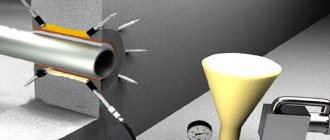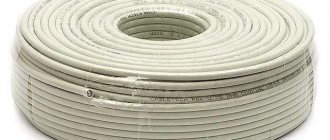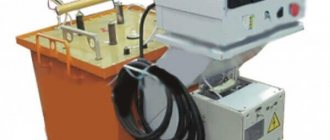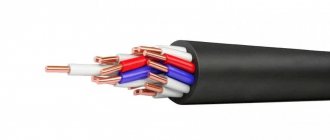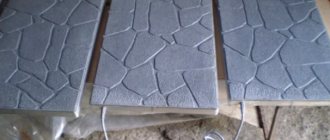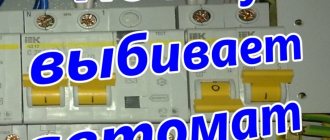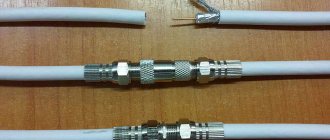- home
Before starting excavation work, you must make sure that there are no underground communications at the site: power cables, communication and data cables, pipelines. To do this, it is necessary to coordinate such work with the services responsible for certain communications. Ideally, these services should confirm the absence of their communications in the specified area, or show where they pass. Unfortunately, in real life this is difficult to do, and in some cases even impossible.
The ideal device for searching for unknown (foreign) communications underground is ground penetrating radar. Such a device is capable of determining all inhomogeneities of the earth's surface at a depth of up to 25 m. Moreover, it can find plastic and metal pipes, power and low-current cables, because it works on the principle of an X-ray machine.
However, due to its high cost, locators are increasingly used to probe the area for the presence of cables. The latter are much cheaper but do not give 100% results, and also require more time and effort to identify unknown communications.
Probing the area is not a function of route finders, however, there are a number of techniques that allow you to detect some metal communications. Let's consider the features of searching for an unknown cable (pipe) with the help of locators, for which we will divide all communications into groups:
Power cables under load and pipelines with cathodic protection
In this case, a fairly large current flows through the cable. Flowing through the cable, the current forms an electromagnetic field, which is easily detected by the receiver in passive search mode. Such cables are looked for first and the probability of finding them is quite high. Most often, this is done by monitoring signals at frequencies of 50Hz (power cables), 100Hz (cathodic protection current of pipelines). To search for a power cable under load on the territory of the site, it is enough to turn on the locator receiver in passive mode and walk along the contour of the area under study. When a cable is detected, you can trace it based on the signal level and mark its location on the site.
How to find cable damage underground
Determining the location of damage to cable lines (LMP), along with confirming and testing the cable , is the main task of the electrical laboratory when carrying out work on the repair and restoration of cable lines .
The search for damage to cable lines must be carried out under the following conditions:
- Electrical laboratory » Questions and answers » What methods exist for detecting cable damage?
During cable operation, cable damage of various natures and origins may occur. They may be caused by manufacturing defects, violations of operating rules, or low-quality installation work. Our engineers classify cable faults into the following types:
- single-phase (the most common) - these are damages in which one of the cable cores shorts to its shell;
— phase-to-phase (these damages account for approximately 1/5 of the total number of all damages);
The photo shows a damaged cable. The search for the location of the cable damage was carried out using one of the methods that allows us to accurately determine the location of the cable damage.
- rupture of cable cores . Occurs as a result of displacement of soil layers in the places where the cable sleeve is located. In some cases, the cause of ruptures may be a manufacturing defect or external damage;
— damage to the plastic sheath of the cable. It is created as a result of mechanical stress due to movements of soil layers, as well as due to incorrect and careless actions during laying. For more detailed information, contact us or request a call back.
Finding cable damage
Cable lines are characterized by a long length and extremely limited access, so finding a cable break . It is impossible to visually search for the location of cable damage, since cable lines are laid deep underground. An incorrect, costly and highly questionable option would be to look for damage to the power cable at random.
Nowadays, the search for the location of cable damage is carried out using modern mobile electrical measurement laboratories. These electrical laboratories have a permanently located set of necessary equipment for carrying out electrical measurements, including instruments such as a cable detector . The mobility of our electrical laboratory allows us to quickly search for the location of a break and accurately determine the depth of the cable .
To find the location of cable damage on the cable route, absolute methods are used that allow you to determine the location of the damage with high accuracy.
Classification of absolute methods:
— acoustic method . Based on listening to sound vibrations caused by a spark discharge in the channel above the cable damage. This method is considered almost universal and is used as the main one for many cable networks. Well suited for identifying various types of damage; in some cases, it allows you to detect several damages on one cable line at once.
— pulse induction method . Searches for the location of cable damage of the “floating breakdown” type. This type of damage comes with special challenges. A “floating breakdown” is an insulation breakdown created under the influence of heat generated as a result of an electrical breakdown. It “floats”, melts, and as a result, the breakdown site is melted, and the cable operates at reduced voltages. Determining the location of this type of fault can last for quite a long period of time until a complete breakdown of the cable insulation occurs and the break becomes noticeable. And this can happen almost at any time. The task of the electrical laboratory is to promptly find the cable in the bundle and promptly repair the damage. The detection method consists of measuring the half-cycle time of the oscillatory electromagnetic process when the integrity of the insulating material is violated. During a breakdown, electromagnetic waves are directed from the breakdown site to the final sections. Based on the location where a change in the direction of signal propagation is noted, we calculate the damaged section of the cable.
- induction method . Based on the principle of determining a magnetic field over a cable passing a current of frequency from 1 kHz to 10 kHz, which is supplied from an audio frequency generator. The method is guaranteed
Low-current cables, de-energized power cables, metal pipelines
Communication cables are mostly shielded (including optical cables) and the electromagnetic field generated by moving electrons cannot be detected on the surface of the earth. The same applies to de-energized power cables and metal pipes. To identify such communications, it is necessary to somehow ensure the transmission of a tone signal over them. This can be done using a generator with an induction antenna, with which you can induce a signal in the cable (pipe) without direct access. An induction antenna creates an electromagnetic field around itself. If an electric current conductor enters such a field, eddy currents appear in it, which spread along the cable and lead to the formation of a new field around the conductor. This field is tracked by the receiver. Ideally, to induce a signal in a cable (pipe), it is necessary to place the generator directly above it. That's why:
- an engineer with a generator stands on one side of the site
- the generator is switched on in the mode of contactless connection to the line using an inductor
- another engineer with a receiver stands at a distance of 20-30m from him
- both begin to move in parallel.
If during movement the pipe ends up between the engineers, the engineer with the receiver will be able to record the signal induced by the engineer with the generator. To determine communications using this method, engineers must divide the entire site into squares of 20-30 m and walk each of them along, across and diagonally.
Locator kits for searching voltage-free cables and metal pipelines
The route-search kit detects, determines the depth and topology of communications that do not radiate on their own, including pipelines. The equipment consists of a receiver (locator), a generator (signal transmitter) and connecting elements. The generator supplies an electromagnetic signal to de-energized cables and metal pipelines. And the receiver picks up electromagnetic waves in specified frequency ranges created by the source of oscillations.
There are two modes of using the tracking kit - active and passive detection. In active detection mode, a generator is activated and the equipment is used to locate objects that do not emit radiation. With passive detection, only the device’s sensors work, which detect interference created by the current flowing through the desired communications.
Causes and types of damage to cable lines
There are many factors that negatively affect the integrity of power cables, the most common of which include the following:
- Ground movement can be caused by a failure of water supply, sewer or heating networks, as well as seasonal phenomena, for example, spring thawing.
- Exceeding the permissible operating standards for cable lines, which can lead to thermal overload of the line caused by an increase in current load.
- Formation of a high level of electric current in the cable line from a transit short circuit.
- Mechanical damage during excavation work without taking into account the passage of underground communications and the depth of the route.
- Errors when laying cable lines. As an example, we can cite violations of the technology for connecting cores with cable couplings.
- Manufacturing defects.
Note that when cable routes are laid open, some of the above causes of damage are extremely rare. In particular, the likelihood of the influence of soil movement and mechanical impacts due to excavation work is reduced. In addition, damage zones of open cable lines, in most cases, can be detected by visual inspection, without the use of special methods.
Having dealt with the reasons, let’s move on to the types of damage, since this directly determines the method by which the emergency section of the cable line will be localized.
Most often, repair teams have to deal with the following types of faults:
- A defect caused by a complete or partial break of a cable line. Most often, the cause of the accident is excavation work without determining the passage of cable routes. Somewhat less frequently, the cause of this damage can be a short circuit in the couplings.
- In power cables (more than 1 kV), breakdown of one of the conductors to ground (single-phase short circuit) is often encountered. Leakage current, as a rule, is caused by a decrease in the quality of insulation during operation of the cable line.
- Interphase damage, as well as types of metal short circuits, can occur in any lines; the cause of damage is the same as in the previous paragraph.
- Routine cable testing, which involves high voltage levels, shows low insulation reliability and leads to breakdown. Under certain circumstances, such a line can continue to operate, but due to its low level of reliability, an accident can occur at any time.
Utility Tracing Tasks
- determining the location of cables (with or without voltage if there are communication access points);
- search for pipes hidden in the ground (water pipelines, sewerage networks, gas pipelines, heating networks, in certain conditions, plastic and asbestos-cement structures);
- tracing of electrical cables and pipes (localization of the route of laying communications with an accuracy of 10 cm);
- identification of unauthorized connections and broken power lines;
- construction of engineering systems diagrams.
| Price for routing utilities | |
| 1. Tracing cables and pipelines underground | from 5000 ₽ |
| 2. Search for hidden communications on a site or construction site | from 5000 ₽ |
| 3. Identification of wiring and pipes in houses and apartments | from 5000 ₽ |
| 4. GPR inspection (polyethylene and asbestos-cement pipes, communication cables, etc.) | from 10000 ₽ |
| 5. Drawing up a report with a diagram | from 1000 ₽ |
Request for a call back
Old-fashioned methods
Of course, previously, to detect wiring in the wall, they did without instruments, but they safely found the entire power line under wallpaper, tiles and plaster. How did our grandfathers and great-grandfathers do it?
We present to your attention the three simplest options that will allow you to find the wiring yourself:
- If a major renovation is planned. You tear off the wallpaper and inspect the wall in the Khrushchev building (or in the house). Typically, the grooves for hidden electrical wiring are slightly different in color from other areas of the surface, and the putty will be rougher to the touch.
- Take an ordinary radio receiver, tune it to 100 kHz and bring it to the required zone. In the place where the current passes, the receiver will begin to make more noise.
- An alternative to the radio is to use a microphone on the radio. Turn on the microphone and carefully move it along the surface. There is a noise or crackling sound - you have managed to find the approximate location of the route.
We draw your attention to the fact that methods that use a microphone and a receiver have a fairly high error of 15 cm. That is why, relying on the signals of these devices, it is better to play it safe and retreat a little more so as not to receive an electric shock! Lifehack with an indicator screwdriver
Lifehack with an indicator screwdriver
That's all the instructions for using devices to detect hidden electrical wiring in the wall. We hope that now you know exactly how to find the wire and power cable under the plaster in the house without anyone’s help!
Related materials:
- How to find a junction box in a wall
- How to replace electrical wiring in a house
- Network surge protection device



